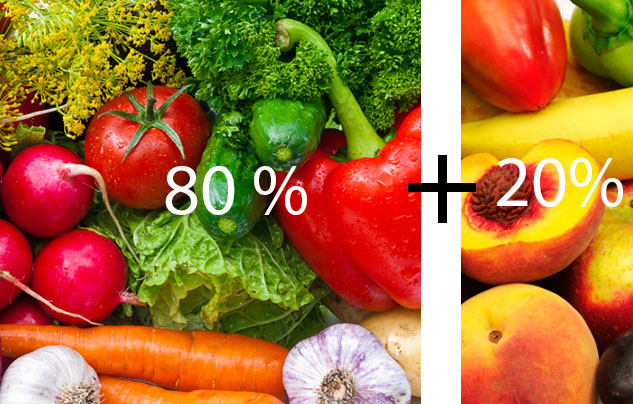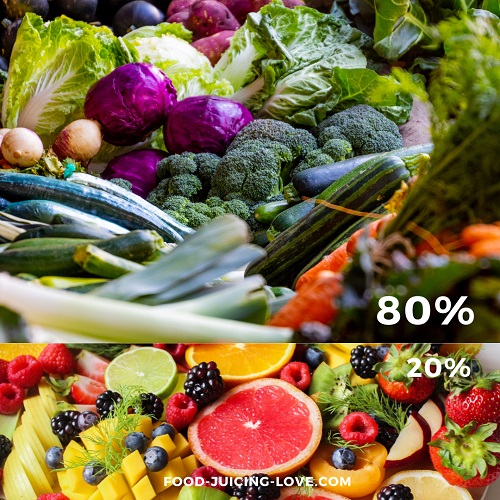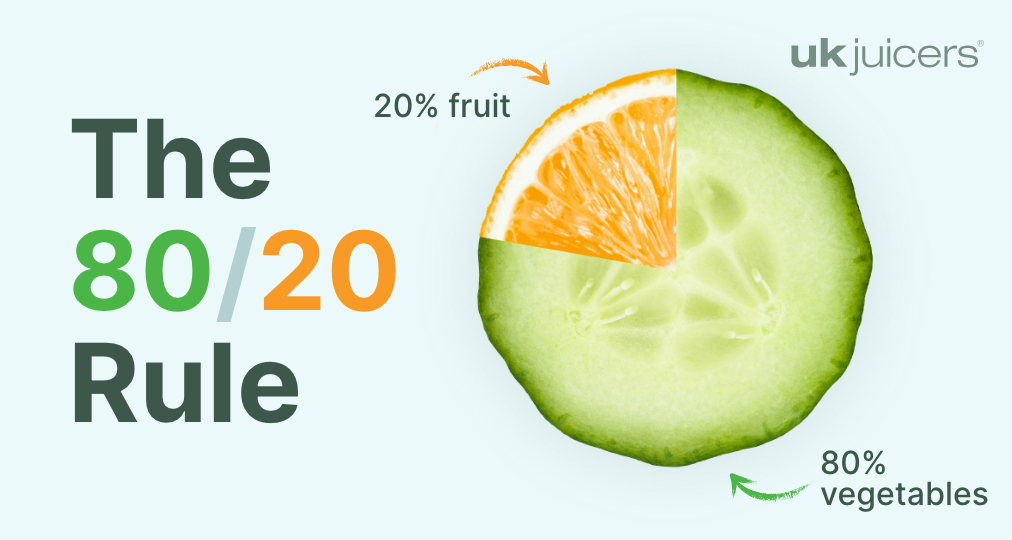In the world of juicing, where countless fruits and vegetables compete for space in your blender, the 80/20 rule offers a refreshing approach to achieving optimal health benefits. This simple principle proposes that 80% of your juice should be composed of vegetables, while the remaining 20% can include fruits.
Why 80/20?
Vegetables are nutritional powerhouses, packed with vitamins, minerals, and antioxidants. They’re naturally low in sugar and high in fiber, promoting gut health and keeping you feeling fuller for longer. Fruits, on the other hand, add sweetness and flavor to your juice but also contribute more natural sugars. By following the 80/20 rule, you can enjoy a delicious, refreshing juice that prioritizes health and minimizes sugar intake.

Benefits of the 80/20 Rule:
- Reduced Sugar Intake: Keeping fruits to 20% helps manage blood sugar levels, reducing the risk of energy crashes and cravings.
- Increased Nutrient Density: A vegetable-heavy juice delivers a concentrated dose of essential vitamins and minerals, supporting overall health and wellbeing.
- Improved Digestion: The fiber content in vegetables aids in digestion, promoting a healthy gut microbiome.
- Weight Management: The lower sugar content and increased fiber can contribute to a balanced diet and aid in weight management efforts.
How to implement the 80/20 Rule:
Experiment with Different Vegetables: Explore a variety of vegetables like leafy greens, cucumbers, carrots, celery, and beets to create diverse and flavorful juices.
Add a Hint of Fruit: Incorporate a small portion of your favorite fruits like berries, apples, or citrus to add natural sweetness and zest.
Get Creative: Add herbs like mint, basil, or ginger to enhance flavor and add additional health benefits.

Juicing Recipe Ideas (Following the 80/20 Rule):
- Green Machine: Kale, spinach, cucumber, celery, green apple
- Beet Boost: Beets, carrots, ginger, orange
- Tropical Twist: Pineapple, mango, spinach, kale, cucumber
Remember, the 80/20 rule is a guideline, not a strict mandate. Feel free to adjust the proportions based on your taste preferences and health goals. The key is to prioritize vegetables while enjoying the sweetness and flavor of fruits in moderation.
Conclusion
Juicing can be a fantastic way to nourish your body and boost your energy levels. By following the 80/20 rule, you can create delicious and nutrient-dense juices that support a healthy lifestyle. So, embrace the power of vegetables and let your juicing journey begin!
FAQs about the 80/20 Rule for Juicing
What is the 80/20 rule for juicing?
The 80/20 rule suggests that 80% of your juice should consist of vegetables, while the remaining 20% can be fruits. This balance prioritizes the nutrient density of vegetables while still enjoying the natural sweetness of fruits.
Why is it beneficial to follow the 80/20 rule in juicing?
Following the 80/20 rule offers several benefits, including reduced sugar intake, increased nutrient density, improved digestion, and potential support for weight management. It allows you to enjoy a flavorful juice that prioritizes health.
Which vegetables are best for juicing when following the 80/20 rule?
Leafy greens (kale, spinach), cucumbers, carrots, celery, beets, and ginger are excellent choices for the vegetable portion of your juice. They offer a variety of nutrients and flavors to create delicious combinations.
What fruits can I include in my juice while following the 80/20 rule?
Berries, apples, citrus fruits (oranges, lemons, grapefruits), pineapple, and mango are popular fruit options for juicing. Remember to keep the fruit portion to around 20% of your total juice.
Can I adjust the 80/20 ratio based on my preferences?
Absolutely! The 80/20 rule is a guideline, and you can adjust the proportions to suit your taste and health goals. If you prefer a sweeter juice, you can slightly increase the fruit portion. The key is to prioritize vegetables while enjoying fruits in moderation.

